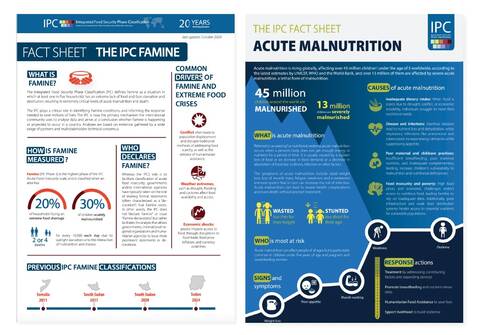IPC Fact Sheets

Type and Objective of Product
Outreach Information Product
IPC Fact Sheets on food security and malnutrition are simplified, visually engaging documents designed to deliver clear and concise information on essential processes, methodologies, and technical concepts. These resources aim to enhance understanding of food security analysis, early warning systems, and decision-making frameworks, making complex topics accessible to a broad audience, including policymakers, humanitarian workers, researchers, and the general public. By combining easy-to-understand language with visual aids like charts, graphs, and infographics, the fact sheets effectively communicate critical insights into food security and malnutrition issues.
Ownership
The IPC Global Support Unit (GSU). is responsible for developing and managing the dissemination and use of Fact Sheets.
Mandatory Content
IPC Fact Sheets serve as a one-stop resource for understanding the complexities of IPC food security and malnutrition analysis, ensuring clarity and depth in their coverage. Here’s how they achieve this:
- Comprehensive Coverage: They delve into all aspects of the IPC classification system, including its five-phase scale.
- Frequently Asked Questions (FAQs): They address frequently asked, contentious or debated areas.
- Technical and Methodological Clarity: They provide detailed explanations of the technical processes involved in IPC analysis, including data collection, validation, and interpretation.
- Visual and Accessible Design: To enhance understanding, the fact sheets use visual aids like charts, graphs, maps, and infographics to simplify complex concepts. They are written in clear, non-technical language to ensure accessibility for a wide audience.
Target Audience
IPC Fact Sheets are designed to meet the needs of four key audiences, including:
- Communications Officers: Organizations responsible for communicating findings and raising public awareness through strategic communication efforts.
- Journalists: Media representatives writing about the crisis.
- Donors: International donors supplying essential funding and resources to support humanitarian initiatives.
- Humanitarian Agencies: UN agencies, NGOs, and donors coordinating and executing humanitarian interventions.
Branding and Format
IPC Fact Sheets follow standardised branding to ensure consistency and credibility:
- Size: Standard A4 book format for easy use.
- Fonts: The primary and secondary font is Myriad Pro, a sans-serif typeface with a classic and fresh appearance that aligns with the IPC brand book.
Dissemination
IPC Fact Sheets are distributed through multiple channels to maximise reach, accessibility, and impact. These channels include:
- Digital Platforms:
- Online Platforms and E-Learning Modules: Hosting Fact Sheets and related guidelines on IPC learning platforms to support self-paced education and training.
- IPC Website: Fact Shets are uploaded to the IPC website, with a dedicated microsite designedfor easy navigation and access.
- Media Engagement:
- IPC Website: Fact Shets are uploaded to the IPC website, with a dedicated microsite designedfor easy navigation and access.
- Media Engagement: Used in training sessions and briefings for journalists and media professionals, supported by press kits to ensure accurate and effective reporting on the IPC and its work.
- Communications Workshops and Webinars: Interactive training sessions for stakeholders to deepen their understanding of the IPC initiative, its processes and their practical application.
- Printed Materials: Printing and distribution of Sheets in physical formats for use in regions with limited digital access or for in-person training sessions.
- Email Outreach: Regular updates to stakeholders, including best practices, case studies, and new resources, to keep them informed and engaged with IPC communication strategies.
- Social Media: Fact Sheet can be instrumental in social media outreach.